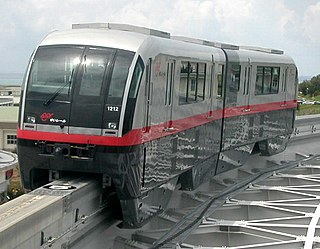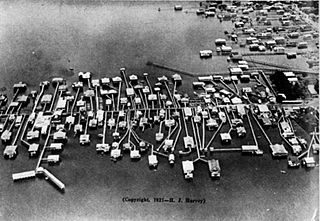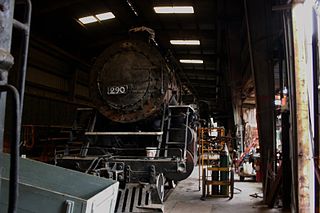
A heritage railway or heritage railroad is a railway operated as living history to re-create or preserve railway scenes of the past. Heritage railways are often old railway lines preserved in a state depicting a period in the history of rail transport.

Streetcars in New Orleans have been an integral part of the city's public transportation network since the first half of the 19th century. The longest of New Orleans' streetcar lines, the St. Charles Avenue line, is the oldest continuously operating street railway system in the world. Today, the streetcars are operated by the New Orleans Regional Transit Authority (RTA).

In railroad structures, and rail terminology, a wye or triangular junction is a triangular joining arrangement of three rail lines with a railroad switch at each corner connecting to the incoming lines. A turning wye is a specific case.

A horsecar, horse-drawn tram, horse-drawn streetcar (U.S.), or horse-drawn railway (historical), is an animal-powered tram or streetcar.

The Delaware-Lackawanna Railroad is a shortline railroad operating in Northeastern Pennsylvania, especially the Scranton area.

The Strasburg Rail Road is a heritage railroad and the oldest continuously operating standard-gauge railroad in the western hemisphere, as well as the oldest public utility in the Commonwealth of Pennsylvania. Chartered in 1832, the Strasburg Rail Road Company is today a heritage railroad offering excursion trains hauled by steam locomotives on 4.02 mi (6.47 km) of track in Pennsylvania Dutch Country, as well as providing contract railroad mechanical services, and freight service to area shippers. The railroad's headquarters are outside Strasburg, Pennsylvania.

The St. Charles Streetcar Line is a historic streetcar line in New Orleans, Louisiana. Running since 1835, it is the oldest continuously operating streetcar line in the world. It is operated by the New Orleans Regional Transit Authority (RTA). Officially the St. Charles Streetcar line is designated as Route 12, and it runs along its namesake, St. Charles Avenue. It is the busiest route in the RTA system as it is heavily used by local commuters and tourists. On most RTA maps and publications, it is denoted in green, which is also the color of the streetcars on this line.

An excursion train is a chartered train run for a special event or purpose. Examples are trains to major sporting event, trains run for railfans or tourists, and special trains operated by the railway company for employees and prominent customers.

The Trona Railway is a 30.5 mi (49.1 km) short-line railroad owned by Searles Valley Minerals. The TRC interchanges with the Lone Pine Subdivision of the Union Pacific Railroad at Searles, California.

Rail transport in Okinawa consists of only the Okinawa Urban Monorail, the only rail line providing rail transportation in Okinawa Prefecture. In the past, Okinawa Island had railroad, trams, and horse-drawn streetcar service. Moreover, Minamidaitōjima and other islands had rail lines to transport sugarcane and other commodities.

Cleveland Lakefront Station is an Amtrak train station at North Coast Harbor in Cleveland, Ohio. The current station was built in 1977 to provide service to the Lake Shore Limited route, which was reinstated by Amtrak via Cleveland and Toledo in 1975. It replaced service to Cleveland Union Terminal. Lakefront Station is located in downtown Cleveland near the Lake Erie waterfront, adjacent to the Cleveland Memorial Shoreway and in the immediate vicinity of the Rock and Roll Hall of Fame, the Great Lakes Science Center, the Steamship William G. Mather Museum and Cleveland Browns Stadium. The station has had little to no renovation since its opening.

The Canal Streetcar Line is a historic streetcar line in New Orleans, Louisiana. It is operated by the New Orleans Regional Transit Authority (RTA). It originally operated from 1861 to 1964. It was redesigned and rebuilt between 2000 and 2004, and operation was reinstated in 2004 after a 40-year hiatus. Primarily running along its namesake street, Canal Street, it consists of two branches named for their outer terminals, totaling about 5+1⁄2 miles (8.9 km) in length: "Canal–Cemeteries" and "Canal–City Park/Museum". Each branch is denoted with the red and light green colors respectively on most RTA publications.

Milneburg was a town on the southern shore of Lake Pontchartrain in Louisiana that was absorbed into the city of New Orleans. A neighborhood to the south of this area is still sometimes known by this name; the former location of Milneburg is now in the Lake Terrace/Lake Oaks, New Orleans section, mostly under the current campus of the University of New Orleans.

The New Orleans and Carrollton Railroad was one of six short-line rail systems built to connect the city of New Orleans, Louisiana, with surrounding neighborhoods, in this case, four-and-a-half miles to the resort village of Carrollton. It was one of the first public transit trolley systems built in the urban United States.

The Rio Grande Scenic Railroad of Colorado was a heritage railway that operated from 2006 to 2019 in and around the San Luis Valley as a subsidiary of the San Luis and Rio Grande Railroad. The heritage railroad ceased operating excursions following a wildfire that damaged some of their facilities, as well as the parent company SLRG entering Chapter 11 bankruptcy in late 2019.

Atlanta and West Point 290 is a P-74 steam locomotive built in March 1926 by the Lima Locomotive Works (LLW) in Lima, Ohio for the Atlanta and West Point Railroad. It is a 4-6-2 heavy "Pacific" type steam locomotive, which was remarkably similar to the Southern Railway's Ps-4 class. With sister locomotive No. 190 built for the Western Railway of Alabama (WRA), No. 290 ferried the Southern Railway's Crescent passenger train from Atlanta, Georgia to Montgomery, Alabama until its retirement from revenue service in 1954. The No. 290 locomotive was saved by a group called the 290 Club and was put on static display at the city of Atlanta's Lakewood Park.


















